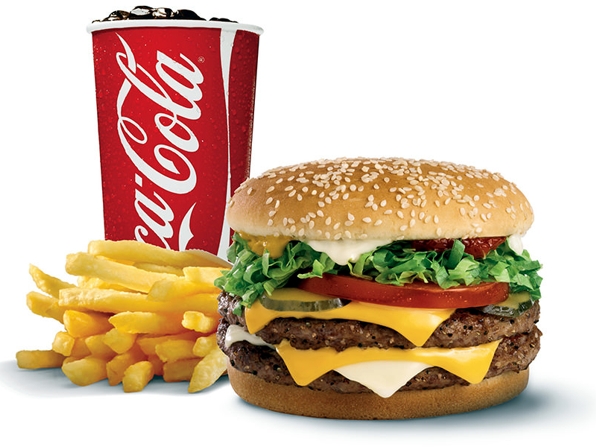The link between Fast Food and cardiovascular disease has been known for some time. But now researchers have revealed that the increased availability of Fast Food joints near one’s home or workplace can increase their risk of heart attack. Did we really need this study?
 An average Fast Food Burger Meal: With a large multi-Patty Burger, Medium
An average Fast Food Burger Meal: With a large multi-Patty Burger, Medium
Fries and a Large Sugar-sweetened beverage, that can account for
1/2 to 2/32 of your daily recommended Calorie allowance…
Researchers at the University of Newcastle in Australia wanted to see whether the mere presence – read: temptation factor – of having easily available fast Food had any effect on the overall cardio health of communities.
Data mining to the fore, again…
So, they looked at the location of the homes of 3,070 patients admitted to hospital with a heart attack between 2011 to 2013, the database contained each patient’s home postal code allowing the researchers to analyse their surrounding fast food environment.
Fast food outlets were defined as the ten most popular quick service restaurant (QSR) chains in Australia, based on a population survey conducted in 2018. The researchers recorded the total number of outlets within each local government area and compared different areas to analyse the association between density of fast food restaurants and incidence of heart attack.
What they found
Areas with a higher number of fast food restaurants have more heart attacks, according to the study. It also found that, for every additional fast food outlet, there were four additional heart attacks per 100,000 people each year.
“Ischaemic heart disease, including heart attack, is one of the leading causes of death worldwide,” Dr. Tarunpreet Saluja, Senior Author of the Study report. “It is known that eating fast foods is linked with a higher likelihood of fatal and nonfatal heart attacks. Despite this, there is rapid growth in the purchase and availability of fast food. This highlights the need to explore the role of food availability in the probability of having a heart attack.”
The takeaway
“The ubiquitous presence of fast food is an important consideration for the ongoing development of rural and metropolitan areas,” Saluja added. “The link with poor health adds a community lens to cardiovascular disease management and stresses the need to target this issue in future public health promotion strategies and legislation. This is why European Society of Cardiology (ESC) guidelines recommend the regulation of fast food outlet density in community settings.”
My take
It just makes sense. Limit the density of Fast Food restos in residential areas and reduce the rate of heart attacks. And, by association, the ever increasing burden on the health care system.
Alas – speaking as one who was once a municipal beat reporter for a great metropolitan radio station – local politicians probably won’t rush to implement regulation s controlling or reducing the density of distance between Fast Food Joints. City politicians, who are in charge of planning decisions, love to give people (read: voters) things they want, and increase the commercial taxation base whenever possible. Luckily, higher level politicians, who are generally responsible for decisions governing the health care system, can override the natural proclivities of local politicians, and bring in policies and regulations to control the location of Fast Food franchise outlets.
Why should we have to legislate the location and density of Fast Food restaurants? Shouldn’t people who are aware that regular Fast Food consumption isn’t healthy be trusted to make their own decisions to eat it or not to eat it? Yes. But this study seems to show that temptation will tend to overwhelm common sense every time…
~ Maggie J.

